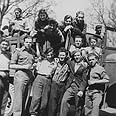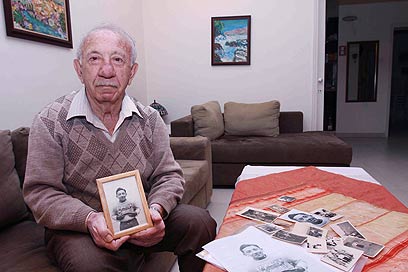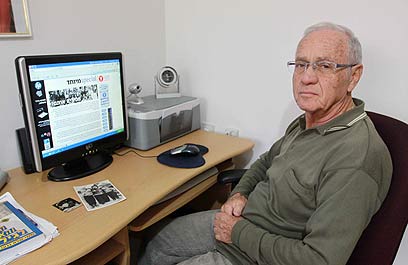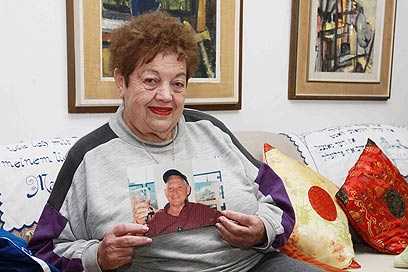
Dachau survivor: In orphanage we became children again
Two weeks ago, Ynet published pictures of 52 children who survived Holocaust, taken in monastery near Nazi concentration camp after war. Four of them recognize themselves in photos, in addition to relatives of deceased survivor who were unaware of this chapter in their father's history. These are their stories
In one moment, Shmuel Rajnsztajn returned to the days after the "Death March", after the American liberation of the Nazi camp at the end of World War II, to the month he spent with his brother Meir at the orphanage in the Kloster Indersdorf monastery, which is located in the southern German town of Dachau, where a concentration camp bearing the same name was active during the war.
Last week, Ynet's Hebrew edition published the photos of the orphans from Dachau, which were discovered by the managers of a school operating in the area today and handed over to the museum located in the camp.
Since the publication, the newsroom received many appeals, leading to the identification of five of the Kloster Indersdorf orphans: Shmuel Rajnsztajn, who was at the orphanage with his brother Meir; Chaim Rechter (Swinik), who was there with his brother Aharon; friends Imre Hitter and Dov Nasch; and the late Zvi Carmi (Henryk Weinberg), who was identified by his family members.
We spoke to all of them this week. Alongside the great excitement and gratitude for the new spark of memory from that significant milestone in their lives, they gladly shared with us additional stops in the long road which took them to the same place – and from there to this day. These are their stories.
'Orphanage was like a palace'
The Rajnsztajn brothers, who were born in Poland, were held at the Blechhammer concentration camp, which was part of the Auschwitz camps complex in Poland, ahead of the war's end. As the Red Army approached, the Germans began marching the prisoners in the camps towards Germany, in an operation dubbed the "Death March".
The brothers were transferred from one camp to another, before being liberated by the Americans near the German city of Regensburg. Shmuel was about 15 years old at the time.
"My brother Meir contracted typhus immediately afterwards," he says. "I took him to the Americans, and they transferred him to an improvised hospital they set up at a school in nearby Neuberg. When I was with him at the hospital, I managed to recognize among the patients one of the SS men pretending to be someone else and turned him in to the Americans."
"I became one of them," he says, referring to the American troops. "They gave me a place to live in the hospital so that I won't be with my brother in the same room, because he was very sick, and they also supplied food and clothes. I remember that at first they only gave us half a cup of oatmeal every two hours, because we were not allowed to eat so much food at once, after the hunger days. I wanted to continue living with them, but that unit moved on to Japan and I couldn't go with them."
The Americans were the ones who handed brothers Shmuel and Meir over to Greta Fischer, a United Nations Refugee Agency worker who collected Jewish orphans from all across Germany and brought them to the monastery's orphanage.
"I remember Greta in British army uniform with a Refugee Agency badge," he continues. "They treated us extraordinarily there. Each of us had a bed. That place was like a palace. Finally we each had a toothbrush and toothpaste, and amounts of food we were not accustomed to. There were even bathtubs there, and nuns who made sure that we used them."
The place's uniqueness, he says, was in the confidence it gave the war's orphans who lived there. "It was a different feeling, that tomorrow morning when we wake up we would still have food and someone to take care of us. It was there that we went back to being children. We had football, a field with a net, and we could actually play like real children."
Like other children from the monastery, Shmuel and Meir were also slated to move on several months later to a foster family in a Western country. The children were sent to England, Switzerland, France or the United States, where the foster families were waiting for them.
"We were supposed to be sent to the US," he recalls. "A day before the trip, they gave us some time to travel to Munich, to buy all kinds of things. My brother met someone there from our town in Poland. He told him that our two sisters had survived and were searching for us."

Shmuel Rajnsztajn remembers. 'We were treated extraordinarily there' (Photo: Ido Erez)
The plan to travel to the US was off, and the two brothers were united with their sisters shortly afterwards. Their older brother, who was a soldier in the Jewish Brigade of the British army, served in Italy after the war and traveled to Germany to meet them. He gave his papers to Meir, who used them to immigrate to Israel in 1946. He later returned them by mail to their rightful owner.
As for Shmuel, his troubles were not over yet. "We immigrated as part of the illegal aliyah, in the 'Moledet' ship," he continues, "but the British soldiers caught us and transferred us to Cyprus. We 'started' Camp 55 in Cyprus, before the Passover holiday of 1946."
He only reached Israel in December 1947, shortly after the UN adopted the partition plan. Today he lives in the central city of Givatayim, is married and has three daughters, eight grandchildren and a great-grandchild.
'It was like a kibbutz'
Like the Rajnsztajn brothers, Chaim and Aharon Rechter (Swinik) also arrived in Indersdorf together. The two, who were born in a town near Minsk in Poland, were living in a Siberian city with their stepmother. Their father was expelled by the Russians to a work camp in the area, and the family hoped they would be able to unite with him at the end of the war.
"After the war ended, we met a man who stayed with my father at the camp, and he informed us that he had died," says Chaim.
"Together with that same person, we returned to Poland. We later traveled with my mother to Germany. She asked to immigrate to Israel, but could not take us with her. That's why Greta took us to the orphanage."
Chaim, 74, was six years old when the war ended. His brother Aharon is three years older than him. The two don't remember much of their life in that place, apart from some segmented memories and experiences.
"There were children there who were collected from all kinds of ghettos and camps," says Aharon. "I remember it was a big hall, like a palace, and the main activity would take place there. They had a monastery and a church there, and the adults – who were preparing to immigrate to Israel – lived in the houses nearby. It was like a sort of kibbutz. Although not everyone spoke the same language, I think the children got along well."
After spending several months in that place, Chaim and Aharon were transferred to foster families in other countries. "At first they sent us to an orphanage, a sort of hostel, in Oxford, England," Chaim recalls. "I even have a school diploma from there. Then we had a foster family in London for two additional years."
Eventually, their stepmother, who remarried, appealed to the Youth Aliyah organization and asked that they be brought to Israel and returned to her. They immigrated to Israel in February 1949.

Chaim Rechter reviews photos on Ynet (Photo: Ido Erez)
Last week, Chaim saw his picture from the camp, which was also published by the Yedioth Ahronoth daily, in which he is seen wearing a soldiers' cap with a mischievous smile on his face.
"I was very moved by it," he says. "The moment I saw the picture in the paper, I shouted to my wife, 'Come see, I'm in the paper.' We then checked out the website and saw the picture there as well."
The family members cannot understand why the picture of Chaim's brother, Aharon, has not been found. They don't know whether his picture was not taken or whether it got lost.
'I was left with nothing but my name'
Of all the orphanage children who recognized their photos, the only one who remembers the circumstances in which his picture was taken is Imre Hitter, 81, who lives in Belgium. Hitter was only 16 years old at the time, alone in the world. The photo, he says, was taken for his identity card.
"I was left alone, with nothing but my name. I had no document or passport. All I had left was my name and origin. I hoped that someone would recognize me, that perhaps someone from my family had survived."
Hitter, who was born in Hungary, managed to survive the Holocaust after he and his family were sent to Auschwitz. At the death camp, he and his three sisters were separated from their parents, who were murdered on the spot.
Hitter was sent to the Flossenbürg concentration camp in Germany, near the Czech border. In 1945, the camp was liberated by American forces. Sixteen-year-old Hitter, who was left alone, was brought to Kloster Indersdorf.
Hitter ruled out the possibility of returning to his homeland of Hungary from the very first moment. "I was left alone, without a family, and I didn’t want to return to Hungary because I hated those people, that nation. In our biggest nightmares we did not imagine that such a thing could happen in Hungary and there was a lot of anger in my heart. A group of orphans slated to be sent to England was formed in the monastery, and I decided to join them and start a new life."
Two years later, Hitter met a relative in England, who told him that his sisters had also survived. Two of the sisters were living at the time in communist Romania and the authorities would not let them leave. Only in 1960 he met them for the first time since their separation in Auschwitz. A third sister immigrated to Israel and started a home and family. Hitter's daughter, Edith Rosenfeld, lives in Israel as well.
In England, Hitter met his future wife, a native Belgian, who suggested that he come with her to her homeland. "I have relatives who survived the Holocaust; at least we'll have a family there," she reasoned. Hitter accepted the offer and settled in Belgium.
Several months ago he was invited to Germany, to the inauguration of a museum at the Flossenbürg concentration camp, where he met 80 other survivors. "Survivors arrived from all across the world, and we saw our photos there as orphans, which were taken at the monastery."
Imre's good friend, Dov Nasch, was also about 15 when he arrived at Indersdorf, and he too lives in Belgium today.
"In a conference which was held there last year, ahead of Greta Fischer's 100th birthday, he was one of the only ones to remember the place," says his son Ronny, who lives in Israel, "although it was essentially a transit place."
The son explains that the American soldiers who liberated the death camps brought the orphans they found to that place, and that the children were later transferred to foster families in England. "He didn't tell us much about that period, but recently he wrote a book about what he went through during the war. He also gives lectures about this issue to non-Jewish school children in Belgium."
'We realized what a hero our father was'
Berta Carmi, Zvi Carmi's widow, was in for a big surprise. Her husband, who was photographed in Indersdorf with a sign bearing his original name, Henryk Weinberg, died several years ago and never told his family that he was one of the children at the German orphanage. The secret was revealed last week, when Berta recognized him in the published photo.
Their son, Ze'ev, recounted last week's discovery. "My mother identified him by his looks, and then also saw his name on the sign. We weren't aware of that chapter in his life. My mother didn't know about it as well. We were very excited. We heard some stories from him, but we didn't know all the details.
"There was a lot of excitement, as well as a feeling of respect, which made us shed tears. It's simply a piece of history, especially in light of the fact that my father himself is no longer alive. I am certain that had he been alive and seen it for himself, he would have been excited too."

He says the photos and their story have shed light on a hidden chapter in the father's life. "It made us realize – from an external party and not first-hand – what a hero our father was and how much he suffered. Dealing with all the difficulties of the war and rehabilitation, without parents, because my father was orphaned during the war. He rose from all this, rehabilitated himself and started a family in Israel. It strongly stings our heart."
Apart from the photo with the sign bearing his name, Carmi appears in another picture with his other friends from the orphanage. His family last week visited an exhibition at the Hadassah Mount Scopus Hospital where the photos are displayed, but could not find other pictures of the father.
Weinberg, who Hebraized his name to Zvi Carmi after making aliyah in 1947, served in the Israel Defense Forces for decades as a career officer and lived in the central city of Ramat Hasharon. He died in 2006 and did not live to see his face staring out from the photo taken during the war.
Roi Mandel contributed to this report
- Click here for the original Hebrew article (Clicking on each photo will enlarge it and include a sign with the child's name). Recognize any of the people in the photos? Contact [email protected]















